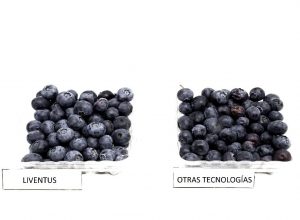It is false that a high CO2 softens the fruit. Softening is mainly linked to set points of high CO2 (>10%) accompanied by low O2 (<6%).
In the industry, there is a tendency to think that high CO2 alone is what softens the fruit, but Liventus, after different studies, has been able to validate that high CO2 accompanied by low O2 has negative consequences for blueberries.
Role of CO2 in fungal control
The blueberry is characterized by being a delicate fruit, very prone to being attacked by fungi as it matures.
In the destination markets there is practically no tolerance for this variable, so its presence can result in a total rejection by the importer. For this reason, it is necessary to effectively combat the proliferation of fungi that come from the field and that are expressed in the post-harvest, especially during maritime transit.
It has been proven that CO2 exerts a fungistatic effect on the fungus, keeping its development at bay, preventing its spread on the fruit. To have an effective control, it is necessary to reach concentrations greater than 8% of CO2.
Analyzing the following graph, it is concluded that there is a directly proportional relationship between the concentration of CO2 and the effectiveness against gray rot caused by Botrytis cinerea.

Figure 1. Effectiveness against Gray Rot as a function of CO2 concentration in Controlled Atmosphere. Source: INIA
Concentrations of this type can only be reached through a Controlled Atmosphere, since a Modified Atmosphere Bag (MAP) is not capable of reaching CO2 concentrations that have an effect on fungi (they are around 4% CO2).
The Liventus Controlled Atmosphere is one of the most outstanding on the market, providing the client with differentiated set points for effective control of fungi, being experts in the constant maintenance of CO2 throughout all maritime transit until the container is opened at destination. .
All our recommendations have been validated by our R&D team in laboratory or commercial studies (in the same containers).

Figure 2. Study conducted by Liventus. 31 days at 0°C in atmosphere + 7 days at 0°C in importer + 3 days at 10°C.
This entry is also available in:
![]() Español
Español
